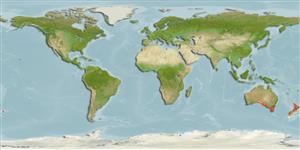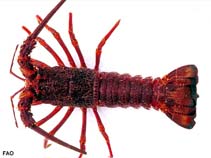Jasus edwardsii (Hutton, 1875)
Red rock lobster| Native range | All suitable habitat | Point map | Year 2050 |

|
| This map was computer-generated and has not yet been reviewed. |
| Jasus edwardsii AquaMaps Data sources: GBIF OBIS |
Classification / Names Common names | Synonyms | CoL | ITIS | WoRMS
Malacostraca | Decapoda | Palinuridae
Environment: milieu / climate zone / depth range / distribution range Ecology
Benthic; depth range 5 - 200 m (Ref. 4). Temperate, preferred 16°C (Ref. 107945); 28°S - 51°S, 114°E - 175°W (Ref. 111521)
Distribution Countries | FAO areas | Ecosystems | Occurrences | Introductions
Indo-West Pacific: Australia, New Zealand and Chatham Island.
Length at first maturity / Size / Weight / Age
Maturity: Lm 9.2, range 7 - ? cm Max length : 58.0 cm BL male/unsexed; (Ref. 4); 43 cm BL (female)
Maximum carapace length of 23.5 cm (male) and 18 cm (female); and minimum legal carapace length of 10 cm (male) and 9 cm (female). Soft shelled specimens are occasionally caught in December and January (Ref. 4). Occurs at depths of 0 to 90 m (seldom at 150 m) on rocky substrate, especially on rocky onshore reefs with sufficient hiding places (Ref. 4). Lives in crevices of rocky shores and among algae (Ref. 4). Also commonly occurs on broken boulder areas and fractured reef (Ref. 106895). It is gregarious and nocturnal. It is carnivorous and feeds on small crustaceans, mollusks and echinoderms (Ref. 4).
Life cycle and mating behavior Maturity | Reproduction | Spawning | Eggs | Fecundity | Larvae
Members of the order Decapoda are mostly gonochoric. Mating behavior: Precopulatory courtship ritual is common (through olfactory and tactile cues); usually indirect sperm transfer (Ref. 833). Mating and egg-laying occurs from May to July after the moult of the female; hatching between July and December of even later (Ref. 4).
Main reference
References | Coordinator | Collaborators
Holthuis, L.B. 1991. (Ref. 4)
IUCN Red List Status (Ref. 130435)
Least Concern (LC) ; Date assessed: 03 December 2009
CITES status (Ref. 108899)
Not Evaluated
CMS (Ref. 116361)
Not Evaluated
Threat to humans
Harmless
Human uses
Fisheries: commercial
FAO - Fisheries: landings | FishSource | Sea Around Us
Tools
More information
Internet sources
BHL | BOLD Systems | CISTI | DiscoverLife | FAO(Fisheries: ; publication : search) | Fishipedia | GenBank (genome, nucleotide) | GloBI | Gomexsi | Google Books | Google Scholar | Google | PubMed | Tree of Life | Wikipedia (Go, Search) | Zoological Record
Estimates based on models
Preferred temperature
(Ref. 115969): 9 - 17.6, mean 14.2 (based on 70 cells).
Prior r = 0.52, 95% CL = 0.34 - 0.78, Based on 5 data-limited stock assessments.
Nutrients: Calcium = 109 [35, 184] mg/100g; Iron = 1.59 [1.21, 1.97] mg/100g; Protein = 20.2 [19.2, 21.3] %; Omega3 = 0.285 [0.185, 0.386] g/100g; Selenium = 48.3 [-31.7, 128.3] μg/100g; VitaminA = 0 μg/100g; Zinc = 1.79 [1.17, 2.40] mg/100g (wet weight).



